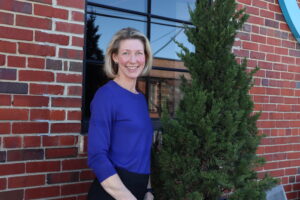 By Amanda Macdonald, Senior Consultant, The Monument Group
By Amanda Macdonald, Senior Consultant, The Monument Group
One of my first jobs in fundraising was as a Campaign Associate for a very large capital campaign at a large institution. My main responsibility was to write thank you letters for campaign gifts of $100,000 and up. I would spend hours working on the perfect adjectives to describe the magnitude of the donor’s generosity and our gratitude. Several drafts would go back and forth between my desk and the CEO’s office, and it would sometimes take days to get a final version of a thank you letter that was normally no more than 5-7 sentences long. Sounds ridiculous, right?
Since that job I have gone on to work in a variety of non-profits, most of which have much smaller operating budgets and do not have the luxury of having an employee that only writes thank you notes for six-figure gifts. But the level of care and attention I was taught to give those donors has stayed with me throughout my career. I have applied that training to all my other fundraising roles and it is a main reason I have been successful in securing gifts, of all sizes, from individual donors.
Major gift fundraising techniques can be, and should be, applied to all donors. The number of individual donors and total giving from individuals were both down in 2022, but I know many small to mid-size non-profits that experienced significant growth in individual giving during this same period. The one thing all these organizations had in common: a major gifts orientation towards individual giving.
Now, understand that I am not talking about donor-centric fundraising, which has caused a lot of damage in our industry. Donor-centric fundraising is a reason many dedicated, bright people from diverse backgrounds have left, or been encouraged to leave, fundraising or non-profit management. I am also not talking about Community-Centric Fundraising, although these techniques fit within a community centric fundraising model.
I am asking you to shift your mindset around “major” donors. Major donors are often defined by a certain level of giving. For a small organization that might be $100, for others it could be $5,000 or $25,000. These donors are set aside and assigned to a development officer so that they can receive personalized communications, access to leadership, and invitations to special events and to serve on volunteer committees. Taking care of these donors and ensuring they see the impact of their support is important. These donors have decided that your non-profit is a priority, and their generosity deserves to be recognized.
But what about donors that don’t fall into this “major donor” definition? Maybe some have the potential to give 10 or 20 times more but need to learn more about your work before investing more. For some donors, they may be “testing” your organization to see how carefully you pay attention to their “starter” gift (remember that donors see our treatment of their gift as a signal to how efficient or competent we are at delivering services).
Most of us don’t have time to do the research on each donor to see who has the greatest capacity. And because most of the interactions you have with these donors is online or through their annual gift, you don’t know what is motivating their giving. By giving them the major donor treatment, you can engage with these donors on a personal level and cultivate increased giving. Successful fundraising always comes down to relationships.
Once you have reexamined your nonprofit’s definition of a major donor, here are some simple tips on how to give all your donors the major donor treatment:
- Keep your acknowledgement letters personal and change up the content! So many gifts come through online, which gives nonprofits the very efficient option of sending an automatic thank you letter via email. We don’t even have mailing addresses for our donors anymore. Make sure this automatic email letter is addressed directly to the donor and references current programs or events. Update this letter every quarter. So many of us work in organizations where every gift, down to the $5 gifts, are necessary to hit our revenue goals. Make sure your donors feel as important as they are.
- Invite conversation in your emails and thank you letters. Ask every donor what motivated their gift. You will find new personal connections that will help you develop relationships.
- If you have a mailing address, send a thank you note and have different people from the organization sign the letter.
- Write personal notes on everything possible. If I get a printed report or letter from an organization I might scan the content, but if I see a handwritten note in the corner or at the bottom of the page, I will certainly take the time to read that. If the message makes me feel appreciated, I will read the rest of the page.
- Send other updates throughout the year, not just thank you letters. Mid-year reports are not just for foundation grant funders or major donors. You can send one via email to donors at all levels. The communication should also include an invitation to a tour or meeting. This gives those donors who truly want to become more invested the opportunity to get more involved. Do not be worried that you will have 100 people accept your invitation for a personal meeting. Worry about that when it happens (and we should all be so lucky!).
- We all know to call first time donors, but making a thank you call to every one of your donors at some point in the year is important. And get the entire organization involved – staff, board members, volunteer committees. At the very least, every development and leadership staff member should set aside at least 20 minutes a week for donor phone calls. You never know what you will learn if you get someone on the phone.
- Personalize your solicitations! Address each communication directly to the donor, using their name. If you are addressing the communication “Dear Friend,” don’t bother sending it because absolutely nobody will read it. Take the time to edit each letter so that the first sentence references their relationship to the organization. If you are mailing a printed letter, have someone write a personal note on every single one.
- Make a specific ask to each donor. We agonize over the amount we are going to request of our major donors, but we will let our lower-level donors renew at the same level year after year. We might ask them to increase, but do they? Try asking your $100 donor to give $150 this year and say why. Say what their extra $50 will help you achieve.
These techniques are best suited to a small to mid-size non-profit that does not have thousands of donors or broad-based direct mail campaigns. But, by just shifting your mindset you will find ways to work with your entire team to implement some of these for your entire donor base. And then what?
You will find that you have more opportunities to talk with all your donors. You will find that many of your smaller-gift donors will give the amount you requested. You will find more major gift prospects. And you will see your individual giving total increase. The $100 donor may think about your request for $150 and decide to forgo that extra dinner out and make the major decision to give $250. The next year, after your personal stewardship, they may decide to give $500, and let you know why when you call to thank them. Over time, they may give at the level your organization defines as “major”, even though you have been treating them as a major donor all along.


